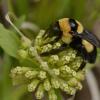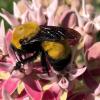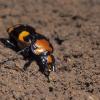
Activity Period and Flash Signal
Adults are active at dusk from early to mid-June. Males and females communicate using a green flash/answer routine.
This subspecies has only been reported from two locations in the Arizona/New Mexico Mountains ecoregion in Yavapai and Greenlee Counties, AZ.
Because this subspecies has only been reported from two sites, not much is known about its habitat associations. However, it is likely a riparian desert specialist. The type locality where this subspecies has been found is located in a seepage area along a creek.
- IUCN Red List status: Endangered
- NatureServe status: G2G3T1T2 - Critically Imperiled, SNR (Arizona)
- U.S. Endangered Species Act status: Petitioned for listing in March 2023
The Gila Southwest spring firefly is threatened by habitat degradation and loss due to mining, trampling by cattle, and modification for pasturing and agriculture, in addition to flooding and light pollution.
- Surveys are needed to determine whether this subspecies occurs in more areas.
- Because flashing firefly species are a rarity in the Southwest, consider reporting any sightings you have to the Firefly Atlas!
- Turn off your outdoor lights at night so the lights of this firefly aren’t diminished by light pollution. You can read more about firefly-friendly lighting in our fact sheet.
- Avoid pesticide use, which could harm this firefly, its habitat, or its prey.
- More research on population size and trend, habitats and ecology, and threats is needed for this species.
Candace Fallon, The Xerces Society for Invertebrate Conservation, based on the IUCN Red List assessment





